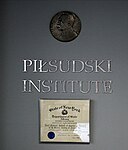The Continental Iron Works was an American shipbuilding and engineering company founded in Greenpoint, Brooklyn, in 1861 by Thomas F. Rowland. It is best known for building a number of monitor warships for the United States Navy during the American Civil War, most notably the first of the type, USS Monitor. Monitor's successful neutralization of the Confederate ironclad CSS Virginia in the 1862 Battle of Hampton Roads—the world's first battle between ironclad warships—would come to heavily influence American naval strategy both during and after the war.
After the Civil War, a severe shipbuilding slump in New York persuaded the Continental Works to diversify into the manufacture of equipment for the growing gas lighting industry, for which the company built gas holders, gas mains and complete gas plants. In 1888, the company built what was then the largest gas holder in the United States. Another notable achievement of the company in the 1880s was the construction of the country's first steel-hulled ferryboats.
In the 1870s, the Continental Works became a pioneer in welding technology, and many innovative welded products would subsequently be produced by it, such as welded corrugated boiler furnaces for ships and other applications, gas-illuminated buoys, steel digesters for wood pulping and welded casings for torpedoes. The company supplied corrugated boiler furnaces for a number of warships, including the battleship USS Maine, and its welding expertise was showcased at the World's Columbian Exposition in 1893 and the St. Louis World's Fair in 1904.
During World War I, the Continental Works built munitions for the war effort, including depth charge casings, and after the war, it increasingly turned to the manufacture of gas mains and large-diameter welded water pipes. The company's assets were liquidated in 1928, following the retirement of the founder's son.







